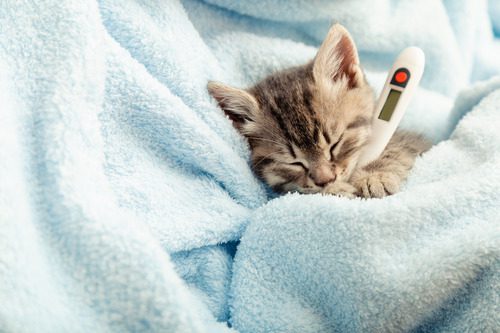
Arthritis in Cats: Signs You Need to Look Out For
Arthritis in cats is a common yet often overlooked condition that can significantly impact your feline friend’s quality of life. Recognizing the signs early and seeking veterinary care can help manage the symptoms and improve your cat’s comfort and mobility. In this article, we will discuss the key signs of arthritis in cats, helping you stay informed and proactive about your pet’s health. If you notice any of these signs, contact Back Bay Veterinary Clinic at (617) 247-2273 or make an appointment for a thorough evaluation.

Understanding Arthritis in Cats
Arthritis, also known as osteoarthritis or degenerative joint disease, is a progressive condition that affects the joints. Over time, the cartilage that cushions the joints breaks down, leading to pain, inflammation, and reduced mobility. While arthritis is more common in older cats, it can affect cats of all ages due to factors such as genetics, obesity, and previous injuries.
The Impact of Arthritis on Cats
Arthritis can significantly affect a cat’s quality of life. Unlike dogs, cats tend to hide their pain and discomfort, making it challenging to identify the early stages of arthritis. Understanding how arthritis impacts your cat can help you detect subtle changes and seek veterinary care promptly.
Common Signs of Arthritis in Cats
Recognizing the signs of arthritis in cats is crucial for early intervention. Here are some common indicators that your cat may be suffering from arthritis:
- Avoid Jumping: You may notice that your cat is reluctant to jump onto furniture or countertops. They may prefer staying on the ground or choosing lower surfaces to jump onto.
- Decreased Activity: Cats with arthritis often become less active. They may spend more time resting and less time playing or exploring.
- Stiffness: You might observe your cat moving stiffly, especially after resting for extended periods. This stiffness is often more pronounced in the morning or after naps.
- Difficulty Climbing Stairs: If your home has stairs, your cat may struggle or avoid climbing them altogether.
- Irritability: Cats in pain may become irritable or more aggressive. They might hiss, growl, or swat when touched or handled.
- Hiding: Cats with arthritis may seek out hiding spots more frequently to avoid movement and interaction.
- Decreased Grooming: Pain and discomfort can make it challenging for cats to groom themselves. You might notice a decline in their coat condition or matting in hard-to-reach areas.
- Avoiding the Litter Box: Cats may avoid the litter box if it’s too high to climb into or if they experience pain while squatting.
- Accidents: You might find that your cat has more accidents outside the litter box, especially in locations that are easier for them to access.
Diagnosing Arthritis in Cats
If you suspect your cat has arthritis, it is essential to consult with a veterinarian. Diagnosing arthritis typically involves a combination of physical examinations, medical history, and diagnostic tests.
Veterinary Examination
During a veterinary examination, your vet will assess your cat’s joint mobility, range of motion, and pain response. They will also look for any signs of inflammation or swelling.
Diagnostic Imaging
To confirm a diagnosis of arthritis, your vet may recommend diagnostic imaging such as X-rays. These images can reveal changes in the joints, including cartilage loss, bone spurs, and joint space narrowing.
Managing Arthritis in Cats
While arthritis is a chronic condition, several strategies can help manage your cat’s symptoms and improve their quality of life.
Weight Management
Maintaining a healthy weight is crucial for cats with arthritis. Excess weight puts additional stress on the joints, exacerbating pain and discomfort. Your veterinarian can recommend a balanced diet and exercise plan tailored to your cat’s needs.
Pain Management
Effective pain management is vital for cats with arthritis. Your veterinarian may prescribe medications such as nonsteroidal anti-inflammatory drugs (NSAIDs) or other pain relievers to reduce inflammation and alleviate pain. It is essential to follow your vet’s guidance and never administer human medications to your cat.
Supporting Your Cat at Home
Making some adjustments at home can also help your cat cope with arthritis more comfortably.
- Comfortable Resting Places: Provide your cat with soft, supportive bedding in easily accessible areas. Consider using orthopedic pet beds to offer extra cushioning for their joints.
- Easy Access to Essentials: Ensure that your cat has easy access to food, water, and litter boxes. Place these essentials on each level of your home to minimize the need for climbing stairs.
- Gentle Exercise: Encourage gentle exercise to keep your cat’s joints moving and muscles strong. Interactive play sessions with toys that encourage movement can be beneficial.
The Importance of Regular Veterinary Visits
Regular veterinary visits are essential for monitoring your cat’s arthritis and adjusting their treatment plan as needed. Your veterinarian can assess the progression of the condition, evaluate the effectiveness of current treatments, and make recommendations for any necessary changes.
Enhancing Your Cat’s Quality of Life
Taking proactive steps to manage arthritis in cats can significantly enhance their quality of life. By recognizing the signs of arthritis and seeking veterinary care promptly, you can help your cat live more comfortably and enjoy their daily activities. If you notice any signs of arthritis in your cat, reach out to Back Bay Veterinary Clinic. Call us at (617) 247-2273 or make an appointment to discuss your cat’s symptoms and explore the best options for managing their arthritis.









